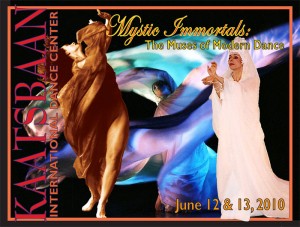Kaatsbaan International Dance Center 2010
3 present loving tribute to dance pioneers
 Daily Gazette, The (Schenectady, NY)-June 14, 2010
Daily Gazette, The (Schenectady, NY)-June 14, 2010
Author/Byline: WENDY LIBERATORE;
For The Daily Gazette
Edition: Schenectady/Albany; Final
Section: B: Local
Page: B5
Column: DANCE REVIEW
TIVOLI — In this world obsessed with the here and now, historic dances are often dismissed as novel oddities, incidents of interest for the dance scholar, perhaps, but wholly unsuitable for the stage.
Three New York dance muses proved this notion terribly misguided in their loving tribute to three of modern dance’s essential pioneers: Loie Fuller, Isadora Duncan and Ruth St. Denis. What this living trio — Jodi Sperling, Jeanne Bresciani and Livia Vanaver — did at Kaatsbaan International Dance Center was more than restage the works of these matriarchs of this American art form. They imbued these groundbreaking, and often revolutionary, dances with a spirit of the very creators themselves. And in so doing, these three living dancers furthered Fuller, Duncan and St. Denis’ status as goddesses who are worthy of infinite worship.
This was especially true of Sperling, depicting Fuller, and Bresciani, as Duncan, as both of these women have dedicated their entire careers to these artists. Vanaver has a vast range of artistic wisdom as a vessel for modern as well as international folk dance and music. But that makes her no less devoted to recreating, preserving and honoring St. Denis. Actually, all three of them are sincere in their awe of these early 20th century artists. And it shows.
In addition, the trio danced works that are not often seen in historic programs, which made this showcase, “Mystic Immortals” doubly wonderful.
Of particular interest were the dances by Sperling, artistic director of Time Lapse Dances. She performed works inspired by Fuller’s billowing dances that used 80 yards of silk and well-placed lighting to create hypnotic visions. (They are inspired as there is no record of the choreography that Fuller created/performed.)
In “Dance of the Elements,” she unfurled her folds of fabric in spell-binding snippets that personified earth, water, wind, fire and ether. Her graceful, but simple manipulation of the silk, which spiraled, rose and descended around her, created optical illusions that were astonishing.
Her works were especially welcome as Fuller is often forgotten by time. More attention is always given to Duncan, who came later, perhaps because she was a controversial sensation.
By today’s standards, Duncan’s dances appear tame. No matter, Bresciani infuses them with a conviction that is startling. She becomes Duncan — a young and innocent iconoclast who is yet untainted by a harsh world that haunted her in the later years. With every breath, Bresciani invoked Duncan. Their connection is divine and it was obvious in her very first piece, “Roses from the South,” as she sprinkled rose petals at the feet of her audience.
Vanaver, for her part, took on her role as the colorful and exotic St. Denis with the precision of an illustrator. A dramatic and handsome woman, Vanaver’s every move, especially with her hands and eyes, was well-placed and meaningful. She, like the Sperling and Bresciani, was gorgeous.
All of this beauty was heightened by the readings of actor Arlene Sterne. She was the voice of Fuller, Duncan and St. Denis, reciting their words as their once radical dances rolled out like a visual timeline of modern dance’s enduring bedrock.
